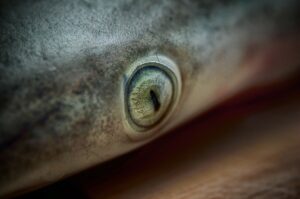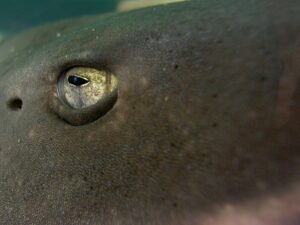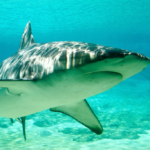If you have a fish and pay attention, you will notice that your fish do not blink. This is because they also lack the eyelashes that humans have. But does it make a difference?
Sharks, like other fish, do not blink in the same way that humans do. Sharks, on the other hand, blink uniquely. This is because they have thin membranes over their eyes, called the nictitating membranes, which act as protective eyelids. However, nictitating membranes are not found in all sharks.
Sharks employ these membranes to protect their eyes from any injury while hunting. These membranes, however, do not obstruct their vision because they are translucent.
Isn’t it fascinating? So, in this piece, we’ve gone through the basics of sharks’ blinking capabilities. We’ll also learn some interesting facts about this topic.
Do sharks blink their eyes?
The majority of fishes lack eyelids, which prevent them from blinking. But what about sharks? Do they not blink as well?
Sharks, contrary to popular belief, can blink their eyes. However, their blinking differs significantly from that of humans. They do not close their eyes all the way. Nonetheless, they have a sliding eyelid or nictitating membrane that covers their eyes during feeding and hunting.

As a result, sharks with this membrane, such as tiger sharks and hammerheads, can blink their eyes anytime they need to. It’s also worth noting that while these sharks rest, they can cover their eyes with this membrane to protect them from any potential injury.
Do sharks blink with both eyes?
Sharks have upper and lower eyelids as well, but they are unable to move them. They do, however, blink distinctively. So, do they have the ability to blink both eyes?
Sharks have the ability to blink with both eyes. When they are feeding or hunting, a unique membrane shields their eyes. In other words, as they battle their prey, this membrane protects both of their eyes, making it appear as if they are blinking with both of their eyes.
The protective membrane on sharks’ eyes is also called their third eyelid. Please remember that this membrane is only found in a few shark species that can blink.
How do sharks without the nictitating membrane blink?

Blinking is necessary to keep the eyes moist and safe from harm. However, not all sharks can blink with their third eyelid. So, how do they do it?
Sharks lacking the nictitating membrane have the capability to roll their eyes backward to protect themselves. However, an ocular rotation occurs when the shark turns its eyes completely back, exposing an incredibly tough piece of cartilage that covers the eyeballs.
This thick cartilaginous coating protects the shark’s eyes from any injury during an attack. One shark species that demonstrates this ability is the great white shark.
Ful seals and stingrays are common prey for great white sharks. As a result, rolling their eyes back protects these fish from being injured by the prey’s sharp claws, fangs, or barbs.
Can sharks close both their eyes?
In a shark’s daily life, sight is extremely important. Hence, they do whatever is required to protect their eyes.
Sharks protect their precious eyes in various ways, one of which is by closing or blinking both of them. This is necessary to protect the eyes from any injury caused by the prey.
This characteristic, however, is only present in sharks with the nictitating membrane. Sharks without this membrane just roll their eyes backward when they need to.
How do sharks blink?
Sharks have a good sense of smell, as well as sight. So their defensive method includes blinking. How do they blink, though?
When sharks attack prey or fight with predators, they close their nictitating membrane and blink. The behavior of that membrane opening and shutting resembles blinking. Nonetheless, their blinking differs significantly from that of humans and other animals with functional eyelids.
However, the eyeball rolls backward in sharks that do not blink, revealing the white connective tissue.
How often do sharks blink?
The fact that sharks do blink is no longer surprising. On the other hand, their blinking is not like that of humans. What is the frequency of these fish’s blinks?
Sharks blink infrequently, and only when their third eyelid or nictitating membrane closes their eyes can they do so. Therefore, sharks remain in closed eye mode when hunting or resting, even though this is a quick process.
Experts have discovered that when sharks get too close to a video camera, they shield their eyes with their unique membrane. Sharks without this skill, on the other hand, just roll their eyes backward. As a result, they never blink.
When do sharks blink?
In a shark’s life, blinking is extremely important. This action aids in the protection of these fish’s eyes. But when do sharks blink?
When sharks hunt or fight, they blink or rather cover their eyes with the nictitating membrane. Sharks also close their eyes when they approach something new out of curiosity. Sharks engage in this reflexive action to protect their eyes from injury.
It’s worth noting that, unlike humans, sharks don’t blink their eyelids very often. Instead, just before hunting or attacking, sharks are rendered nearly blind by blinking or rolling their eyes backward. As a result, they rely heavily on other senses, including electroreception and scent.
Why do sharks not blink?
The majority of fish do not blink. On the other hand, Sharks are unique in that some of them can really open and close their eyes. But why don’t they all do it?
Because some shark species lack the nictitating membrane, they cannot blink. Great white sharks, for example, lack this membrane and so do not blink. They can, however, roll their eyeballs back when necessary to protect themselves from damage.
In other words, sharks do not blink in the same way that we do. Instead, they close or hide their eyes to protect themselves from predators or dangerous prey.
FAQs
Q: Do sharks blink?
A: No, sharks do not blink in the same way that humans do.
Q: How do sharks keep their eyes moist?
A: Sharks use a third eyelid called a nictitating membrane to keep their eyes moist.
Q: Do sharks have eyelids?
A: Yes, sharks have eyelids, but they are not like the eyelids of other animals.
Q: Can sharks close their eyes?
A: Yes, sharks can close their eyes, but not in the same way that humans do.
Q: How do sharks protect their eyes from damage?
A: Sharks have a transparent eyelid called a nictitating membrane that helps protect their eyes from damage.
Q: When do sharks close their eyes?
A: Sharks close their eyes when they are attacking prey or being handled by humans.
Q: Do sharks sleep?
A: Yes, sharks do sleep, but they do not close their eyes while sleeping.
Q: Do fish have eyelids?
A: No, most fish species do not have eyelids.
Q: How are shark eyes like?
A: Shark eyes are similar to human eyes in structure, but they do not have eyelids that close.
Q: Why don’t sharks blink?
A: Sharks do not have a need to blink because they have a third eyelid called a nictitating membrane that keeps their eyes protected.
Summary
Sharks’ blinks are actually different than those of other species. Sharks are fish that can open and close their eyes, to put it simply. Blinking is feasible for these fishes because of the nictitating membrane. However, sharks’ eyelids do not entirely close, and there is a small gap between them.





